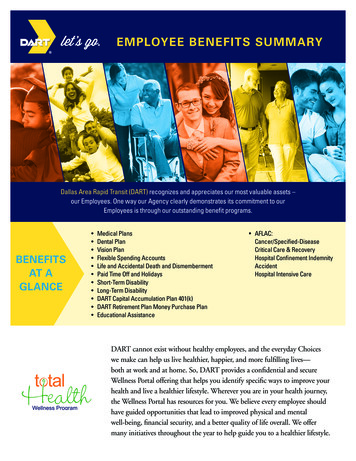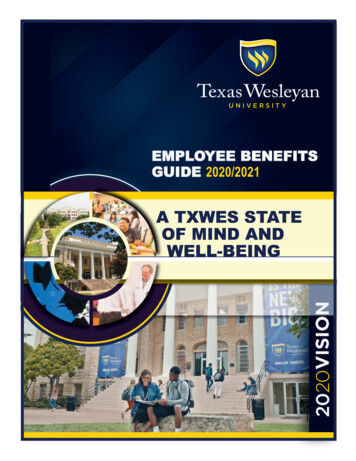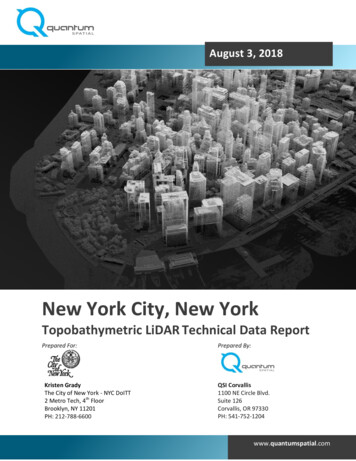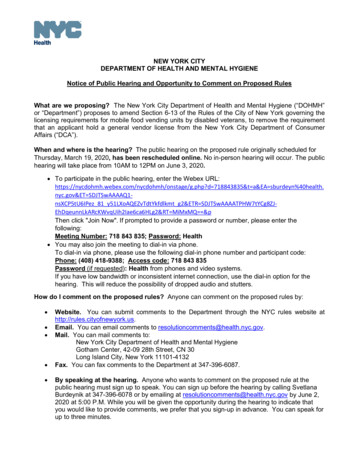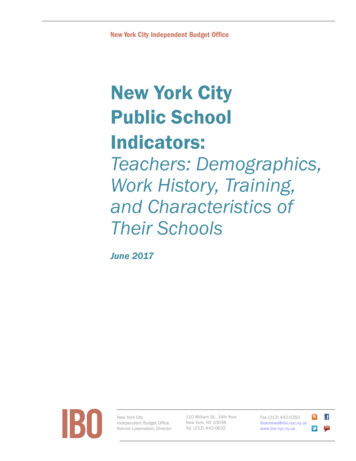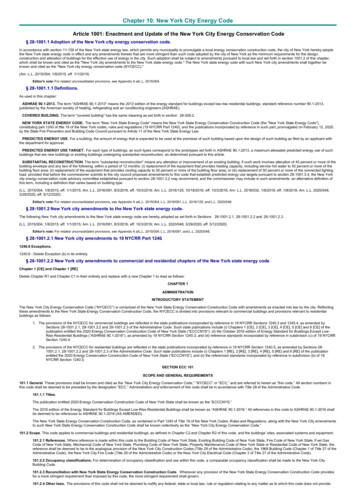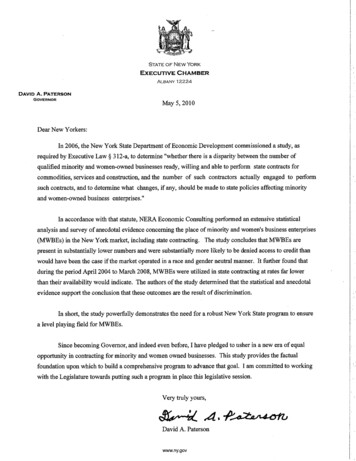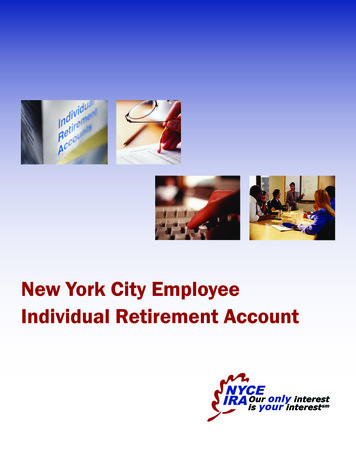
Transcription
New York City EmployeeIndividual Retirement Account
Office of Labor RelationsDeferred Compensation Plan & NYCE IRA22 Cortlandt Street, 28th Floor, New York, NY 10007Tel: 212 306-7760 / Outside NYC: 888 DCP-3113 and 888 IRA-NYCEnyc.gov/deferredcomp and nyc.gov/nyceiraBoard MembersMayor of the City of New YorkComptroller of the City of New YorkCommissioner, Office of Labor RelationsDirector, Office of Management & BudgetCommissioner of FinanceCommissioner, Citywide Administrative ServicesPolice CommissionerFire CommissionerUniformed Firefighters AssociationDistrict Council 37, AFSCMECorporation Counsel, Counsel to the BoardRenee CampionCommissionerSteven H. BanksFirst Deputy CommissionerGeneral CounselGeorgette GestelyDirector, Employee Benefits ProgramBeth KushnerDeputy Director, AdministrationSang HongDeputy Director, OperationsDear City or Former City Employee:Thank you for your interest in the New York City Employe IRA, the NYCE IRA!Other IRAs charge individual retail rates! In the NYCE IRA, you are not a retail customer. Instead,you are able to continue investing in the Deferred Compensation Plan’s low cost investment optionsand portfolios, make contributions of earned income and roll over other employer plans and IRAs toconsolidate your assets. The NYCE IRA is also available to the spouses of current and former Cityemployees. Make sure your spouse opens a Spousal NYCE IRA to take advantage of this importantbenefit.We also encourage you to attend the Deferred Compensation Plan’s free financial planning seminars.Visit the Plan’s Web site at nyc.gov/deferredcomp to view seminar dates and times, and to registerfor a seminar. You may also register by calling (212) 306-5050.We are pleased to offer the NYCE IRA and hope you’ll take advantage of this great savingsopportunity.Sincerely,Georgette GestelyDirector2
Funding Your Traditional NYCE IRA 6Funding Your Roth NYCE IRA 8Establishing a Spousal NYCE IRA 10Selecting Your NYCE IRA Investments 12Traditional NYCE IRA Withdrawals 14Table of ContentsIntroducing the NYCE IRA 4Roth NYCE IRA Withdrawals 15NYCE IRA Beneficiary Information 16Fee Disclosure Statement 18Disclosure Statement 19NYCE IRA Application (Tear off)5k02/193
Introducing the NYCE IRAWhat is the NYCE IRA?The New York City Employee Individual Retirement Account (NYCE IRA) is another retirement savings vehicle fromthe New York City Deferred Compensation Plan. The NYCE IRA includes both a Traditional IRA and a Roth IRA for theexclusive benefit of current and former employees of the City of New York and their spouses. Open a NYCE IRA andenjoy the convenience, professionalism and performance of a program that has been designed with only you in mind.No commissions, no sales charges, no self-interest. Our only interest is your interest!What is the difference between a traditional IRA and a Roth IRA?There are two forms of IRAs: a traditional IRA and a Roth IRA.Traditional IRARoth IRAMaximum yearlycontribution 6,000 ( 7,000 if age 50 or older) for 2019 6,000 ( 7,000 if age 50 or older) for 2019Are there incomelimitations forcontributions?Yes, if actively participating in an employer-sponsoredretirement plan (see chart on page 6)Yes. Anyone with modified Adjusted Gross Incomebelow 137,000 (single) or 203,000 (married filingjointly) may contribute to a Roth IRA.Annual contributiondeadlineTax-filing deadline for the year. Contribution must bereceived by the NYCE IRA Administrator prior to thetax-filing deadline for the year.Tax-filing deadline for the year. Contribution must bereceived by the NYCE IRA Administrator prior to thetax-filing deadline for the year.Is there an age restriction on contributions?Yes. You cannot make contributions beginning withthe year you reach age 70½.NoTax AdvantageFederal Tax-Deferred GrowthFederal Tax-Free GrowthAre there required minimum distributions duringmy lifetime?Yes. Distributions must begin by the April 1 followingthe year you reach age 70½.No. Distributions are not required during your lifetime.Is there federal incometax on distributions?Yes, to the extent that a distribution represents deductible contributions and investment earnings.Not for Qualified Distributions. For non-QualifiedDistributions, only the earnings portion is taxable.Is there a 10% penaltyon early distributions?Yes, the penalty applies to taxable distributions ifyou are under age 59½ and do not qualify for anexception.Yes, the penalty applies to the earnings portions ifyou are under age 59½ and do not qualify for anexception.Do beneficiaries payincome tax on distributions after the IRAowner’s death?Yes, to the extent that a distribution representsdeductible contributions and investment earnings.Generally, no, as long as it is a Qualified Distribution.stAll IRAs are tax deferred. That means you do not owe taxes on any earnings until you make a withdrawal. If you qualify, you may also beable to deduct your contributions to a traditional IRA on your federal income tax return, deferring tax on that amount as well. Contributionsto a Roth IRA are not tax deductible, however, a Qualified Distribution from a Roth IRA is income tax-free. (Refer to page 15.)Am I eligible to open a NYCE IRA?If you are a current or former New York City employee (with a termination date of 1985 or later), you are eligible toestablish a NYCE IRA.Is my spouse eligible to establish a NYCE IRA?If you are eligible to establish a NYCE IRA and you are married and file a joint tax return, your spouse is eligible to havea NYCE Spousal IRA. Please refer to Establishing a NYCE Spousal IRA in this guide for details.What are the advantages of establishing a NYCE IRA? Contributions: Continue making contributions while you are still working or after you leave City service. As long asyou receive taxable compensation, even after you retire or leave City service, you are eligible to contribute to the Traditional NYCE IRA until age 70½. There is no age limit for making contributions to the Roth NYCE IRA. Consolidation: Consolidate all retirement plan accounts into the NYCE IRA. Simply move your retirement accountssuch as your retail IRAs, and previous employer plans (457, 401(k), 403(b), etc.) to the Traditional NYCE IRA. TheRoth NYCE IRA accepts rollovers from Roth 401(k) Plans and other retail Roth IRAs. Low cost and no pressure, theNYCE IRA offers you a great place to consolidate your retirement plan assets. Deposit of Tax Refund: You can arrange to have a portion of your federal income tax refund deposited into yourNYCE IRA account. Investment Options: The NYCE IRA has the same low management fee investment options including Pre-ArrangedPortfolios as the Deferred Compensation Plan.4
Accessibility: The NYCE IRA gives you unrestrictedaccess to your money. Defer Taxes and Avoid Penalties: Rolling over to theNYCE IRA defers the taxes of a deferred compensation plan distribution and avoids early withdrawalpenalties. Tax Flexibility: With the NYCE IRA, you can choosenot to pay taxes when you withdraw from a TraditionalNYCE IRA account, but when they’re due by the taxfiling deadline. By law, 20% of a 401(k), 457 or 403(b)withdrawal is withheld for federal taxes. Qualified distributions from a Roth NYCE IRA account are incometax free.Once you have your PIN, you are ready to go on tothe next step. Return to the NYCE IRA Web site to setup your account as follows:1) Designate whether you are establishing aTraditional NYCE IRA or Roth NYCE IRA.2)With the NYCE IRA, you can choose how you wantyour money invested. The NYCE IRA offers youthe opportunity to invest in a Pre-Arranged Portfolio.Each portfolio consists of varying percentages of theNYCE IRA’s core investment options. They are professionally managed and regularly rebalanced foryou. Each portfolio’s risk exposure is automaticallyreduced over time. Estate Planning Flexibility: The NYCE IRA is ideal forleaving rolled-over 457 and 401(k) assets to a childor grandchild. And, with no required distributions, theRoth NYCE IRA provides an income tax free inheritance for beneficiaries.You may choose instead to create your own portfolio from the NYCE IRA’s seven core investmentoptions. The core options include a Stable IncomeFund, a Bond Index Fund, a Global Socially Responsible Index Fund, an Equity Index Fund, aMid-Cap Equity Index Fund, an International EquityFund, and a Small-Cap Equity Fund. Spousal IRA: Spouses can take advantage of the lowcost investment options through the Deferred Compensation Plan by establishing a NYCE Spousal IRAand make contributions and consolidate their retirement assets. Spousal accounts must be establishedprior to the employee’s death.Please refer to the investment fund profiles (available online at nyc.gov/nyceira or by calling (212)306-7760, or 1-888-IRA-NYCE, if outside NYC) fordetailed information, including past performance.See Selecting Your NYCE IRA Investments in thisguide for information on how to change your investment allocation and transfer money between investment options.Am I eligible to make contributions to the NYCEIRA? If you satisfy certain taxable compensation requirements and adjusted gross income limits for a particularyear (please refer to Funding Your Traditional NYCEIRA and Funding Your Roth NYCE IRA in this guide);and3)Are there any fees when opening a NYCE IRA?There are Two Ways to Establish aNYCE IRA Account Set Up Your Account ElectronicallyFirst, visit the NYCE IRA Web site at nyc.gov/nyceiraand select “sign-in/set up account” to request yourmaterials. You will receive a Personal IdentificationNumber* (PIN) through regular mail which is requiredto complete the establishment of your NYCE IRA andprovide you with future access to your account.Designate Your BeneficiariesYou may designate more than one individual orentity as beneficiary of your account. If you have aRoth NYCE IRA and a Traditional NYCE IRA, youmust select separate beneficiaries for each account.Please refer to the NYCE IRA Beneficiary Information section of this guide for additional information. If you are under age 70½ at the end of the year, youcan make Traditional NYCE IRA contributions for thatyear (there is no age limit for making contributions tothe Roth NYCE IRA).Administrative charges are currently 20.00 per quarter.If you already have a Deferred Compensation Plan account, you will only be charged a single administrativefee per quarter. In addition, the Plan’s investment fundsare assessed an annualized asset based fee of 0.04%.Investment option fund expense ratios can be foundon the Plan’s Web site at nyc.gov/nyceira or call (212)306-7760 for the Plan’s investment option Fund Profilesheets.Select Your Investment Allocation4)View the Disclosure StatementTo complete the process, after you have made yourinvestment allocation and beneficiary choices, youmust read and acknowledge the Disclosure Statement and fee schedule.After you have established your account, you willreceive a confirmation letter, a PIN*, which will provideyou with future access to your account, and the formsnecessary to fund your account.OR Complete the attached NYCE IRA ApplicationOnce we process your NYCE IRA Application, you willreceive a confirmation letter, a PIN*, which will provideyou with future access to your account, and the formsnecessary to fund your account.* The IRA account owner is responsible for keeping the assigned PINconfidential. Please contact the NYCE IRA Administrator immediately ifyou suspect any unauthorized use.5
Funding Your Traditional NYCE IRAThere are two ways to fund your Traditional NYCE IRAaccount, through contributions made by check androllovers.ContributionsHow much can I contribute to the Traditional NYCEIRA?The contribution limit to your Traditional NYCE IRA willbe the lesser of the following amounts: 6,000 in 2019; or Your taxable compensation for that year.If you will be age 50 or over the most that you can contribute to your Traditional NYCE IRA will be the lesser ofthe following amounts: 7,000 in 2019; or Your taxable compensation for that year.How much can be contributed to a Traditional NYCESpousal IRA?The contribution limit is the same as that of the Traditional NYCE IRA.What is taxable compensation?Generally, taxable compensation is wages, salaries,tips, professional fees, bonuses, and other amounts youreceive for providing personal services. You must havecompensation to be eligible to make contributions to theNYCE IRA. Compensation does not include any of thefollowing items: Earnings and profits from property, such as rentalincome, interest income, and dividend income. Pension or annuity income (including distributionsfrom 457 plans, 401(k) plans, 403(b) plans and IRAs).What if I have more than one IRA?If you have more than one IRA, either traditional or Roth,the limit applies to the total contributions made on yourbehalf to all your IRAs for the year.Generally, you can deduct the contributions to yourtraditional IRA on your federal income tax return. Pleaserefer to Establishing a NYCE Spousal IRA in this guidefor information on the deductibility of a Spousal NYCEIRA.Whether your contributions into the Traditional NYCEIRA will be deductible or non-deductible depends onyour (or, if married, you and your spouse’s) modifiedAdjusted Gross Income (modified AGI) and whether ornot you are covered by another retirement plan at work.The deductibility of your Traditional NYCE IRA does notaffect the IRA maximum contribution limit. Even whenyour contributions are not tax deductible, any earningsstill grow tax-deferred.The City of New York, its custodian, and service providers are not responsible for determining or tracking yourdeductible and your non-deductible contributions to theTraditional NYCE IRA.Modified AGI is calculated from information on your taxreturn. The Form W-2 you receive from your employerhas a box used to indicate whether you were covered bya retirement plan for this year. If the “Retirement Plan”box is checked, you were covered for this year.The following tables explain the extent to which yourNYCE IRA is deductible:If you are covered by a retirement plan at work*If your filingstatus is.Single orhead ofhouseholdMarried filingjointly orqualifyingwidow(er)And your modifiedAGI is.Then you can take.Up to 64,000A full deductionFrom 64,000 but lessthan 74,000A partial deduction 74,000 or moreNo deductionUp to 103,000A full deductionFrom 101,000 butless than 123,000A partial deduction 123,000 or moreNo deductionIf you are NOT covered by a retirement plan at work*If your filingstatus is.And your modifiedAGI is.Then you can take.Making a contribution to your NYCE IRA is easy. Afterestablishing a Traditional NYCE IRA, simply send acheck or money order for the amount desired, specifyingit is a traditional IRA Contribution, along with a NYCEIRA Deposit Form to the address stated on the form.The minimum initial deposit is 100. You can contributeas often as you like but remember you are responsiblefor making sure you do not contribute in excess of theIRA contribution limits.Single orhead ofhouseholdor qualifyingwidow(er)Any amountA full deductionMarried filingjointly witha spousewho is notcovered by aplan at workAny amountA full deductionIs there a deadline for making contributions?Married filingjointly or witha spouse whois covered bya plan at workUp to 193,000 or lessA full deductionFrom 193,000 butless than 203,000A partial deduction 203,000 or moreNo deductionHow do I make a contribution to my NYCE IRA?Contributions can be made to your Traditional NYCEIRA at anytime during the year or by the deadline forfiling your federal income tax return for that year, withoutincluding extensions. Contributions to the NYCE IRAmust be received by the Plan’s custodian prior to thetax-filing deadline.6Can I deduct my contributions to the NYCE IRA?The tables above are only applicable to contributions made in2019.* If you want to work out the numbers yourself, see IRA Publication 590;otherwise, see a licensed tax professional.
RolloversIf the assets are from the City’s 457 Plan or 401(k)Plan, they can be rolled over after severancefrom City service (or attainment of age 59½ in the401(k) Plan). Once you have established yourNYCE IRA account, you will need to submit a NYCDCP Distribution Form, as well as the NYCE IRATransfer/Rollover Form, transferring your assets.What is a rollover?Generally, a rollover is a tax-free distribution from a previous retirement plan or IRA that you transfer to anotherretirement plan or IRA. A rollover does not counttowards the annual IRA contribution limit and it is not adeductible contribution.What are the different kinds of rollovers accepted bythe Traditional NYCE IRA?The Traditional NYCE IRA will accept rollovers from aprevious employer’s retirement plan and the City’s 457Plan or pre-tax 401(k) Plan and 403(b) after severancefrom City service or attainment of age 59½ (401(k) or403(b)). In addition, the Traditional NYCE IRA may bethe perfect place to consolidate your other traditionalIRAs.The only distributions from a pre-tax retirement plan ortraditional IRA that are not eligible for roll over to theTraditional NYCE IRA are the following:1) Periodic Payments from a pension, annuity or retirement plans (401(k), 457, 403(b) or IRA) that aremade at least once a year and that will last for:(a) your life expectancy,(b) your life expectancy and your beneficiary’s lifeexpectancy, or(c) a specified period of ten years or more2)Required Minimum Distributions3)Hardship WithdrawalsIf the distribution you received from the previous pre-taxretirement plan was made payable to you, you can stillroll it over to the Traditional NYCE IRA, however, 20%of your eligible retirement plan distribution would havebeen withheld for federal income taxes. In order to rollover 100% of the distribution, you would have to useyour own savings to replace the 20% that was withheld.The NYCE IRA administrative office must receive acheck from you within 60 days of your receipt of thedistribution, in order for you to receive credit for the 20%that was withheld toward your income tax. However, ifyou don’t have the cash to make up for the 20% withheld, and only roll over the 80% of your plan distributionthat you received, the IRS will consider that 20% as adistribution, making it subject to taxes and a possible10% early withdrawal penalty.You can obtain these forms through the Forms andDownloads section of the Office of Labor Relations’Web site at nyc.gov/olr.3)Have your plan/IRA administrator or former employer make the check payable to:Traditional NYCE IRAFBO: your full name and the last four digits of yourSocial Security Number Direct them to mail the check to:Via regular mail:NYCE IRAP.O. Box 392057Pittsburgh, PA 15251-9057Via express mail:NYCE IRAP.O. Box 392057500 Ross St. 154-0455Pittsburgh, PA 15262-0001Wire Instructions:BNY Mellon, New York, NYABA/Routing Number: 021000018For credit to:NYC Deferred Compensation Plan/NYCEIRAAccount#: 8900623829FBO: (Name of Account Owner)Upon receipt of the Incoming Rollover Form and thefunds, you will receive a NYCE IRA confirmation letterafter your account has been credited. The assets will beinvested in accordance with the investment allocation onfile with the program.Please refer to Selecting Your NYCE IRA Investments inthis guide to learn more about your available investmentoptions.The only way to avoid this withholding is to have yourprevious retirement plan make your distribution checkpayable to the Traditional NYCE IRA.How do I roll over assets into the Traditional NYCEIRA?After establishing a Traditional NYCE IRA, rolling overassets from a previous retirement plan or IRA is simple:1)Notify your plan/IRA administrator and/or formeremployer that you are rolling over your assets to theNYCE IRA.2)Submit a NYCE IRA Transfer/Rollover Form.7
Funding Your Roth NYCE IRAThere are two ways to fund your Roth NYCE IRAaccount, through contributions made by check androllovers/conversions.ContributionsHow much can I contribute to the Roth NYCE IRA?The contribution limit to your Roth NYCE IRA will be thelesser of the following amounts: 6,000 in 2019; or Your taxable compensation for that year.If you will be age 50 or over the most that you can contribute to your Roth NYCE IRA will be the lesser of thefollowing amounts:Your eligibility to make contributions to the Roth NYCEIRA depends on whether or not you have taxable compensation and your adjusted gross income and tax filingstatus.The City of New York, its custodian, and service providers are not responsible for determining or tracking thecost basis (non-taxable contributions) to the Roth NYCEIRA.The following table explains the extent to which you areeligible to contribute to a Roth NYCE IRAIf your filingstatus is. 7,000 in 2019; or Your taxable compensation for that year.How much can be contributed to a Roth NYCESpousal IRA?Single or headof householdAnd your modifiedAGI is.Then you cancontribute.Up to 122,000Up to the limitFrom 122,000 butless than 137,000A reduced amount 137,000 or moreZeroUp to 193,000Up to the limitFrom 193,000 butless than 203,000A reduced amount 203,000 or moreZeroThe contribution limit is the same as that of the RothNYCE IRA.Married filingjointly or qualifying widowerWhat is taxable compensation?The table above is only applicable to contributions made in 2019.Generally, taxable compensation is wages, salaries,tips, professional fees, bonuses, and other amounts youreceive for providing personal services. You must havecompensation to be eligible to make contributions to theRoth NYCE IRA. Compensation does not include any ofthe following items: Earnings and profits from property, such as rentalincome, interest income, and dividend income. Pension or annuity income (including distributionsfrom 457 plans, 401(k) plans, 403(b) plans and IRAs).What if I have more than one IRA?If you have more than one IRA, either traditional or Roth,the limit applies to the total contributions made on yourbehalf to all your IRAs for the year.How do I make a contribution to my Roth NYCE IRA?Making a contribution to your Roth NYCE IRA is easy.After establishing a Roth NYCE IRA, simply send acheck or money order for the amount desired, specifying that it is a Roth Contribution, along with a NYCE IRADeposit Form to the address stated on the form. Theminimum initial deposit is 100. You can contribute asoften as you like but remember you are responsible formaking sure you do not contribute in excess of the IRAcontribution limits.Is there a deadline for making contributions?Contributions can be made to your Roth NYCE IRA atanytime during the year or by the deadline for filing yourfederal income tax return for that year, without including extensions. Contributions to the NYCE IRA must bereceived by the NYCE IRA Administrator prior to the taxfiling deadline.8Am I eligible to make contributions to a Roth NYCEIRA?If you want to work out the numbers yourself, see IRAPublication 590; otherwise, see a licensed tax professional.If you are not eligible to contribute to the Roth NYCEIRA, or your Roth contribution is in excess of the maximum annual IRA contribution limit, excess contributionsmust be distributed from the NYCE IRA prior to the taxfiling deadline for the taxable year. If you fail to removethe amounts, you are subject to an annual 6-percentexcise tax on those contributions.Unlike a traditional IRA, you cannot deduct contributions to a Roth IRA. But, if you satisfy the requirements,Qualified Distributions are tax free. (See the sectionentitled Roth NYCE IRA Withdrawals.) Contributions canbe made to your Roth IRA after you reach age 70½ andyou can leave amounts in your Roth IRA as long as youlive.Rollovers/ConversionsWhat is a rollover?Generally, a rollover is a tax-free distribution from aprevious retirement plan or IRA that you transfer to another retirement plan or IRA. A rollover does not counttowards the annual IRA contribution limit and it is not adeductible contribution.What are the different kinds of rollovers accepted bythe Roth NYCE IRA?The Roth NYCE IRA will accept rollovers from the City’sRoth 401(k) Plan, Roth 457 Plan, previous Roth 401(k)and Roth 457 plans, and Roth IRAs.
Rollover from a previous Roth IRA to the Roth NYCEIRA.A rollover to the Roth NYCE IRA must be completedwithin 60 days after distribution from a previous RothIRA to the employee. Only one Roth IRA rollover ispermitted every 12 months. Roth IRA assets may notbe rolled over to other types of IRAs, e.g., traditional orSimple IRA.A rollover of a Qualified Distribution from a previousRoth IRA to the Roth NYCE IRA would be treated astax-free.How do I roll over assets into the Roth NYCE IRA?After establishing a NYCE IRA, rolling over assets froma previous Roth 401(k) plan, Roth 457 plan or Roth IRAis simple:1)Notify your plan/IRA administrator and/or formeremployer that you are rolling over your assets to theRoth NYCE IRA.2)Submit a NYCE IRA Incoming Rollover Form.If the assets are from the City’s Roth 401(k) Plan orRoth 457 Plan, they can be rolled over after severance from City service (or attainment of age 59½ inthe 401(k) Plan). You will need to submit an NYCDCP Distribution Form, as well as the NYCE IRATransfer/Rollover Form. You can obtain these formsthrough the Forms and Downloads section of theOffice of Labor Relations’ Web site at nyc.gov/olr.Rollover from Roth 401(k) or Roth 457 to Roth IRAA rollover of a Qualified Distribution from the City’s Roth401(k) Plan, Roth 457 Plan or another Roth 401(k) orRoth 457 plan to the Roth NYCE IRA would be treatedas tax-free. However, the investment return on thatamount earned in the Roth NYCE IRA would be subject to applicable taxes and penalties unless deemed aQualified Distribution upon withdrawal.In the case of a rollover of a non-Qualified Distributionfrom the City’s 401(k) Roth Plan or Roth 457 Plan to theRoth NYCE IRA, the period that the rolled-over fundswere in the 401(k) Roth or 457 Roth Plan does NOTcount towards the 5-taxable-year period for determininga Qualified Distribution from the NYCE Roth IRA. Theportion of the distribution that constitutes Roth 401(k) orRoth 457 non-taxable contributions would be treated astax-free in the Roth IRA.The following are amounts that are not eligible for rollover to the Roth NYCE IRA:1)Excess elective deferrals pursuant to IRC section415;2)Loans that are treated as deemed distributions pursuant to IRC section 72(p).Am I able to fund my Roth NYCE IRA account byconverting money from my Traditional NYCE IRA ortraditional retail IRAs or rolling over from my DCPPre-tax 457 or Pre-tax 401(k)?Yes, a Roth IRA conversion consists of amounts rolledover, transferred, or considered transferred from a nonRoth IRA, such as a traditional IRA or the DCP Pre-tax457 Plan or Pre-tax 401(k) Plan. Assets distributed froma non-Roth IRA will be reported to the IRS as a taxabledistribution, subject to applicable income tax. Conversions to the Roth NYCE IRA will not be subject to penalties for premature distributions. Converting money tothe Roth NYCE IRA enables you to avoid future incometaxes on any subsequent Roth NYCE IRA QualifiedDistributions.3)Have your plan/IRA administrator/formeremployer make the check payable to:Roth NYCE IRAFBO: your full name and the last four digits of yourSocial Security Number Direct them to mail the check to:Via regular mail:NYCE IRAP.O. Box 392057Pittsburgh, PA 15251-9057Via express mail:NYCE IRAP.O. Box 392057500 Ross St. 154-0455Pittsburgh, PA 15262-0001Wire Instructions:BNY Mellon, New York, NYABA/Routing Number: 021000018For credit to:NYC Deferred Compensation Plan/NYCEIRAAccount#: 8900623829FBO: (Name of Account Owner)Upon receipt of the Incoming Rollover Form and thefunds, you will receive a NYCE IRA confirmation letter. The assets will be invested in accordance with theinvestment allocation on file with the program.Please refer to Selecting Your NYCE IRA Investments inthis guide to learn more about your available investmentoptions.Please consult a tax advisor prior to making a conversion to a Roth IRA.9
Establishing a Spousal NYCE IRAThe Spousal NYCE IRA is a tax-favored retirementsavings vehicle for spouses of eligible New York Cityemployees. The Spousal NYCE IRA is available as botha traditional or Roth IRA with the same advantages as aNYCE IRA and can be used to make contributions andconsolidate retirement assets.Please refer to the investment fund profiles (availableonline at nyc.gov/nyceira or by calling (212) 306-7760,or 1-888-IRA-NYCE, if outside NYC) for detailed information, including past performance. See Selecting YourNYCE IRA Investments in this guide for information onhow to change your investment allocation and transfermoney between investment options.Is my spouse eligible to establish a NYCE IRA?How do I establish a Spousal NYCE IRA?What is a Spousal NYCE IRA?If you are eligible to establish a NYCE IRA and you aremarried and file a joint tax return, your spouse is eligibleto have a Spousal NYCE IRA. The Spousal NYCE IRAmust be established using your spouse’s own name andSocial Security number, joint accounts are not allowed.In order to verify eligibility to establish a Spousal NYCEIRA, the employee must establish his or her own NYCEIRA. The employee does not have to contribute orconsolidate assets into his or her NYCE IRA, he or shesimply must open a NYCE IRA account. See Introducing the NYCE IRA in this guide for instructions on establishing a NYCE IRA account.How is a Spousal NYCE IRA funded?A Spousal NYCE IRA can be funded through contributions or rollovers. Contributions – B
such as your retail IRAs, and previous employer plans (457, 401(k), 403(b), etc.) to the Traditional NYCE IRA. The Roth NYCE IRA accepts rollovers from Roth 401(k) Plans and other retail Roth IRAs. Low cost and no pressure, the NYCE IRA offers you a great place to consolidate your retirement plan assets.


